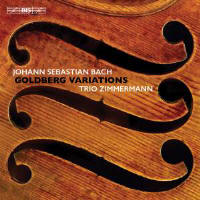Reviewer: Raymond
Tuttle
Violinist Dmitry Sitkovetsky
created and recorded (for Orfeo) a version of the Goldbergs for
string trio that was “in memoriam Glenn Gould.” In a written introduction to
the present release, Trio Zimmermann acknowledges Sitkovetsky’s version but,
reading between the lines, appears to find it lacking. They write, “... [W]e
became captivated by the original score and its innumerable beauties and
details. We have therefore decided to offer a string trio version which
is—as far as possible—neither an arrangement nor a transcription, but
basically an unveiling of Bach’s score.” I do not find the Sitkovetsky
version more or less “veiled” than this new one, and anyway, in this
context, I am unsure about what “veiled” even means. More to the point,
perhaps, the Sitkovetsky version (with violist Gérard Caussé and cellist
Mischa Maisky) is played more Romantically (with more vibrato and freer
phrasing, etc.) than this new one, but that has more to do with performance
styles than with transcriptions or arrangements. If Trio Zimmermann feels
that their version, played more authentically than Sitkovetsky’s, is
“unveiled,” it hurts no one to let them continue to feel that way. At least
it doesn’t hurt me!
The members of Trio Zimmermann are just about as famous, within
their generation, as Sitkovetsky’s group is in theirs. They are violinist
Frank Peter Zimmermann, violist Antoine Tamestit, and cellist Christian
Poltéra. I would have liked to read more about what strategies the three
musicians employed to divide up a two-handed keyboard work in which every
third variation is a canon. To me, this sounds like a much taller order than
arranging the Goldberg Variations for orchestra, for example. If this work
had been arranged for an orchestra, there would have been no expectation
that all parts of the orchestra shared the performance more or less equally.
A string trio, on the other hand, is a chamber ensemble, of course, and
favoring one instrument over another is clumsy and inconsistent with the
spirit of chamber music. Zimmermann, Tamestit, and Poltéra give themselves
and each other equal time in this new version. Although Zimmermann takes the
lead in the “Aria” and the “Aria da capo,” throughout the work, each
musician is given opportunities to be put in the spotlight—to carry the
melody and to show off his virtuosity.
Purists probably will object to this work being played by a string
trio, but if they can get over that, then they should find much to approve
of here. As I wrote above, Trio Zimmermann has taken authenticity of style
into consideration more than Sitkovetsky’s group did, and at no point does
this version sound odd on unmusical. (Don’t forget that, in recent years, we
have had arrangements of the Goldberg Variations for all kinds of
instruments, including for guitar, for harp, and for accordion, so perhaps a
string trio isn’t as much of a stretch.) The faster variations are played
with infectious high spirits, and in the so-called “Black Pearl” variation
(No. 25) there is almost as much introspection as one would expect to hear
in a performance on a harpsichord or a piano. The final variation, the
Quodlibet, could have been played with more earthy humor, but it is
consistent with the spirit of this performance overall.
Given the
elegance of the playing, and the performers’ obvious concern for maintaining
a period style, it is hard not to recommend this recording, even if it is
played on the “wrong” instruments. This project turned out nicely. It gives
the Sitkovetsky version a run for its money—and then some!
Fermer la fenêtre/Close window
|




